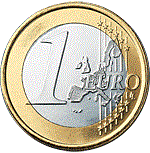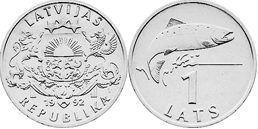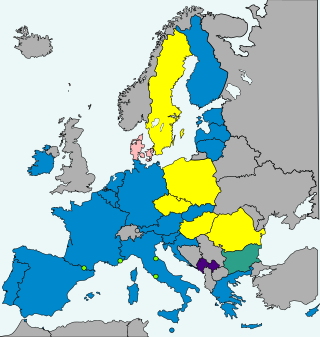
There are eight euro coin denominations, ranging from one cent to two euros. The coins first came into use in 2002. They have a common reverse, portraying a map of Europe, but each country in the eurozone has its own design on the obverse, which means that each coin has a variety of different designs in circulation at once. Four European microstates that are not members of the European Union use the euro as their currency and also have the right to mint coins with their own designs on the obverse side.

Britannia is the national personification of Britain as a helmeted female warrior holding a trident and shield. An image first used by the Romans in classical antiquity, the Latin Britannia was the name variously applied to the British Isles, Great Britain, and the Roman province of Britain during the Roman Empire. Typically depicted reclining or seated with spear and shield since appearing thus on Roman coins of the 2nd century AD, the classical national allegory was revived in the early modern period. On coins of the pound sterling issued by Charles II of England, Scotland, and Ireland, Britannia appears with her shield bearing the Union Flag. To symbolise the Royal Navy's victories, Britannia's spear became the characteristic trident in 1797, and a helmet was added to the coinage in 1825.

The Latvian lats was the currency of Latvia from 1922 until 1940 and from 1993 until it was replaced by the euro on 1 January 2014. A two-week transition period during which the lats was in circulation alongside the euro ended on 14 January 2014. The lats is abbreviated as Ls and was subdivided into 100 santīmi, abbreviated as an s after the santīm amount.

Fractional currency, also referred to as shinplasters, was introduced by the United States federal government following the outbreak of the Civil War. These low-denomination banknotes of the United States dollar were in use between 21 August 1862 and 15 February 1876, and issued in denominations of 3, 5, 10, 15, 25, and 50 cents across five issuing periods. The complete type set below is part of the National Numismatic Collection, housed at the National Museum of American History, part of the Smithsonian Institution.

The postal history of Malta began in the early modern period, when pre-adhesive mail was delivered to foreign destinations by privately owned ships for a fee. The earliest known letter from Malta, sent during the rule of the Order of St John, is dated 1532. The first formal postal service on the islands was established by the Order in 1708, with the post office being located at the Casa del Commun Tesoro in Valletta. The first postal markings on mail appeared later on in the 18th century.

Gold and silver issues of the euro commemorative coins are collectors' euro coins not primarily intended for general circulation; the commemoratives also include rare cases of bimetal collector coins, such as titanium and niobium.

Euro gold and silver commemorative coins are special euro coins minted and issued by member states of the Eurozone, mainly in gold and silver, although other metals are also used on rare occasions. Malta introduced the euro (€) on 1 January 2008. In a short time, the Central Bank of Malta has been producing both normal issues of Maltese euro coins, which are intended for circulation, and commemorative euro coins in gold and silver.

The United States dollar is the official currency of the United States and several other countries. The Coinage Act of 1792 introduced the U.S. dollar at par with the Spanish silver dollar, divided it into 100 cents, and authorized the minting of coins denominated in dollars and cents. U.S. banknotes are issued in the form of Federal Reserve Notes, popularly called greenbacks due to their predominantly green color.

Revenue stamps of Malta were first issued in 1899, when the islands were a British colony. From that year to 1912, all revenue issues were postage stamps overprinted accordingly, that was either done locally or by De La Rue in London. Postage stamps also became valid for fiscal use in 1913, so no new revenues were issued until 1926–1930, when a series of key type stamps depicting King George V were issued. These exist unappropriated for use as general-duty revenues, or with additional inscriptions indicating a specific use; Applications, Contracts, Registers or Stocks & Shares. The only other revenues after this series were £1 stamps depicting George VI and Elizabeth II. Postage stamps remained valid for fiscal use until at least the 1980s.

Melita is a national personification of Malta. The name originated from the Punic-Roman town of Melite, the ancient capital of Malta which eventually developed into the city of Mdina.
Banknotes of the United States dollar are currently issued as Federal Reserve Notes (1914–).
The designers of Maltese stamps have been creating their works for the last 150 years. The most prolific designer of Maltese stamps was Emvin Cremona, who designed most of Malta's stamps from the late 1950s to the 1970s. Dates indicate the years stamps with the artist's design were used.

The St Paul's Shipwreck 10/- black is a postage and revenue stamp issued by the Crown Colony of Malta on 6 March 1919, and it is generally considered to be the country's rarest and most expensive stamp. It is rare because a very limited quantity of 1530 stamps was printed and it was inadvertently issued prematurely by the Post Office.
The National Bank of Ukraine has issued four banknote series since 1996. All banknotes in denominations of ₴1, ₴2, ₴5, ₴10, ₴20, ₴50, ₴100, ₴200, ₴500 and ₴1,000 issued after 2003 are considered legal tender. All of them depict an important person in Ukraine's history on the obverse and a landmark place on the reverse. The lowest four denominations are no longer issued in banknotes and are intended to be gradually substituted by coins, though they remain common. There have been four commemorative banknote issues.

The Great Siege Monument, also known as the Monument to the Fallen of the Great Siege, is a monument commemorating the Great Siege of Malta located in Valletta, Malta. It consists of three bronze figures symbolizing Faith, Fortitude, and Civilization, standing on top of a granite base. The monument is the work of the sculptor Antonio Sciortino, and it was inaugurated on 8 May 1927.

The Melita issue is a series of dual-purpose postage and revenue stamps issued by the Crown Colony of Malta between 1922 and 1926, depicting the national personification Melita. They were commemorative stamps since they celebrated the islands' new status as a self-governing colony following a new constitution in 1921, but also a definitive issue intended for regular use over an extended period of time.

Gianni Vella was a Maltese artist. After studying in Rome, he produced many religious works which can be found in many churches in the Maltese Islands, but he also produced some secular works including landscape paintings, cartoons and a stamp design.

Count Alfredo Caruana Gatto was a Maltese lawyer, politician and naturalist.


















